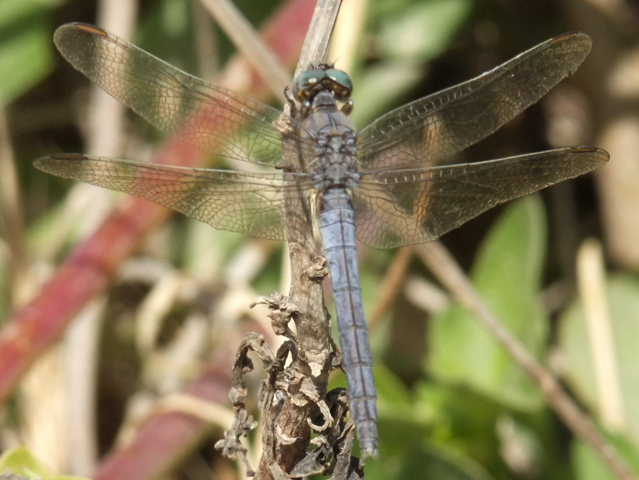|
|
|
|
|
Galleria Tassonomica
di
Natura Mediterraneo
|
 Nota! La determinazione degli insetti necessita quasi sempre di un'indicazione geografica e temporale precisa. Nota! La determinazione degli insetti necessita quasi sempre di un'indicazione geografica e temporale precisa.
Invitiamo quindi gli utenti ad inserire questi dati ogni volta che viene richiesta una determinazione o viene postata una foto di un insetto. I dati forniti dagli utenti ci consentiranno anche di attribuire un valore scientifico alle segnalazioni, contribuendo a migliorare e integrare le attuali conoscenze sulla distribuzione delle specie postate.
|
|
| Autore |
 Discussione Discussione  |
|
|
xilpa
Utente Senior
   

Città: Malta

1461 Messaggi
Flora e Fauna |
|
|
Selys
Utente Senior
   
Città: Mosta (Malta)

611 Messaggi
Flora e Fauna |
 Inserito il - 26 luglio 2012 : 20:25:57 Inserito il - 26 luglio 2012 : 20:25:57


|
Hi Albert,
It's a male which is not yet fully mature. Females and young males are of a different colour.
Immagine:

49,86 KB |
Charles Gauci |
 |
|
|
gomphus
Moderatore
    

Città: Milano
Prov.: Milano
Regione: Lombardia

10487 Messaggi
Tutti i Forum |
 Inserito il - 26 luglio 2012 : 22:02:56 Inserito il - 26 luglio 2012 : 22:02:56


|
ciao albert
and moreover, in males (as that of your photos) and in females (as that of the last one) terminal appendages are differently shaped
don't rely too much on the color; very old females often become quite like mature males |
 maurizio maurizio
quando l'ultimo albero sarà stato abbattuto,
l'ultimo fiume avvelenato, l'ultimo pesce pescato,
allora ci accorgeremo che il denaro non si può mangiare
|
 |
|
|
Selys
Utente Senior
   
Città: Mosta (Malta)

611 Messaggi
Flora e Fauna |
 Inserito il - 27 luglio 2012 : 09:37:16 Inserito il - 27 luglio 2012 : 09:37:16


|
Hi Maurizio,
You are right about old individuals of odonata females approaching the colour of males. This especially so in Ischnura genei where females can be exactly the same colour as males (as in attached photo)
Other species, such as Crocothemis erithraea and Orthetrum coerulescens, are never as bright as their male counterparts.
Another point is that females normally perch away from water and only go to the water body to copulate and oviposit.
Immagine:

35,85 KB
Immagine:

32,03 KB
Immagine:

44,33 KB |
Charles Gauci |
 |
|
|
xilpa
Utente Senior
   

Città: Malta

1461 Messaggi
Flora e Fauna |
 Inserito il - 27 luglio 2012 : 10:26:28 Inserito il - 27 luglio 2012 : 10:26:28


|
Many thanks to you both.
I had noticed that mature females which would normally be yellowish do change their colour and do come to resemble males, but i should have noticed that the appendages in this individual are close together which indicates a male.
I was not too sure about this one because of the yellowish patches on the abdomen, which normally are brownish.
Charles, would it be possible for you to let me know where you cames across this female ? I would very much like to add it to my collection.
Regards.
Albert
|
Photos: Link
http:Link
|
 |
|
|
Selys
Utente Senior
   
Città: Mosta (Malta)

611 Messaggi
Flora e Fauna |
 Inserito il - 27 luglio 2012 : 12:03:40 Inserito il - 27 luglio 2012 : 12:03:40


|
Hi Albert,
I took the picture yesterday at Ghadira Nature Reserve (where I used to work and where I still carry out bird-ringing). I also saw females at Ghajn Rihana and in the valley below Mselliet school this week. The best way to look for them is by the side of the path (usually overgrown with giant reed) running parallel to the water body. Sometimes they are approachable but at other times they fly away quite easily. |
Charles Gauci |
 |
|
|
xilpa
Utente Senior
   

Città: Malta

1461 Messaggi
Flora e Fauna |
 Inserito il - 27 luglio 2012 : 12:53:55 Inserito il - 27 luglio 2012 : 12:53:55


|
Many thanks Charles, I will try to go next week.
Regards. |
Photos: Link
http:Link
|
 |
|
| |
 Discussione Discussione  |
|
|
|
 Natura Mediterraneo Natura Mediterraneo |
© 2003-2024 Natura Mediterraneo |
 |
|
Leps.it | Herp.it | Lynkos.net
|

 Forum
|
Registrati
|
Msg attivi
|
Msg Recenti
|
Msg Pvt
|
Utenti
|
Galleria |
Map |
Forum
|
Registrati
|
Msg attivi
|
Msg Recenti
|
Msg Pvt
|
Utenti
|
Galleria |
Map |